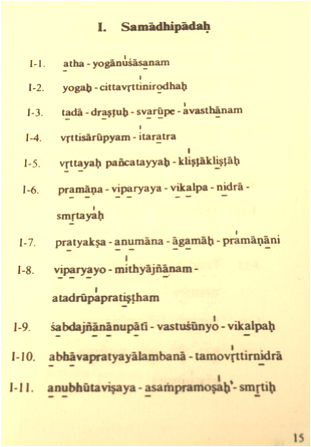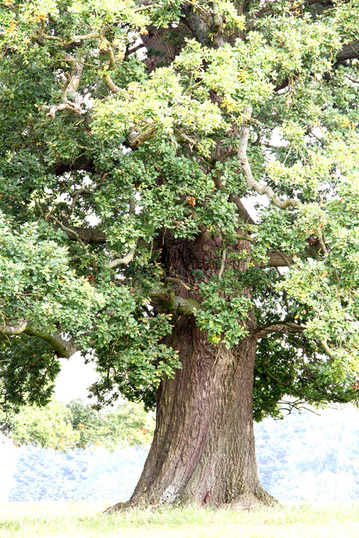
The Antarayas are the 9 obstacles presented in chapter 1.30 of the Yoga Sutras as cittavikṣepāḥ: disturbances which distract and trouble the mind and prevent clear perception.
They are:
In Sutra 1.31 the symptoms of these challenges or obstacles are then listed as: duḥka – bad space or suffering; daurmanasya - a negative state mind or depression; ạngamejayatva – physical instability; śvāsapraśvāsāh vikṣepasabhuvaḥ – difficulty regulating breathing (inhalation and exhalation).
The 9 obstacles have been interpreted differently by many yoga teachers and philosophers. BKS Iyengar separated the 9 obstacles in 'Light on the Yoga Sutras' into 4 different categories:
The late Peter Hershnack presented the Antarayas as problems with:
Bernard Bouanchaud makes note in his reflections on the yoga sutras that 'it is possible to establish a cause and effect relationship between each obstacle by following the order of presentation. For example, our health is compromised, so we cannot think clearly, we question everything and confuse ourselves further, we act in haste to try and rectify our situation, becoming more confused and muddled we then start to feel exhausted, look for a quick fix to help alleviate the immediate problems and then fall backwards, losing confidence and motivation...' He then goes on to say that 'each of the Antarayas can also occur independently and certain obstacles crop up again and again depending on the individuals concerned.' And so the obstacles which cloud our perception do not always begin with ill health.
The good bit: the solutions!
You will be glad to hear that all is not lost...we can do something to keep obstacles at bay!
In the following sutras 1.32 – 1.39 a number of solutions and strategies are presented as a means of steadying the mind and promoting clear thinking, good health, vitality and direction.
1.32 – Come back to or persevering with one essential principal or practice - anything which brings steadiness to the mind and the body. This could be your yoga practice, a meditation practice, a daily pranayama practice, your daily walk with the dog, 20 minutes of reading or studying something inspiring, time spent talking through things with someone supportive. 'Sticking to a single practice, method, and instructor without distraction is an ideal proposal for those who are unstable or in doubt. The choice of a single principal must be a good one and one should proceed methodically. (Bernard Bouanchaud) 'If one can select any appropriate means to steady the mind and practise this, whatever the provocations the obstacles cannot take root.' (TKV Desikachar) We must remember that less is more, 'one' essential principal means just that – focussing on a single, simple and effective commitment or priority is much more achievable and sustainable than trying to focus on many.
1.33 – Cultivate friendliness in the presence of happiness, active compassion in the presence of unhappiness, joy in the presence of virtue and indifference towards error. 'The mind becomes clear and serene when these qualities are cultivated' (Alistair Shearer) 'This aphorism directly addresses our relationships with others. It points out the attitudes to develop in daily life' (Bernard Bouanchaud) and indirectly suggests we should take responsibility for our attitude and state of mind. In order to cultivate the noble qualities listed above we may need to take time out to reflect, question or meditate on our actions and we may find that the first step to embracing these qualities is to detach from activities or patterns of thinking that get in the way. 'If we can be pleased with others who are happier than ourselves, compassionate towards those who are unhappy, joyful with those doing praiseworthy things and remain undisturbed by the errors of others, our mind will be very tranquil.' (TKV Desikachar)
1.34 – Consciously regulating the breath by developing the exhalation and the pause after the exhalation helps to quieten the mind. Pranayama practise is one of the principal yoga techniques which can directly help us to maintain composure and clarity when the mind feels agitated or busy. Regular pranayama practise can increase the concentration of vital energy (prana) in the system and reduce stress on the body and the mind. By focussing on the exhalation 'we eliminate impurities on the physiological, psychological and even spiritual levels.' (Bernard Bouanchaud)
1.35 – The mind becomes more focussed and less distracted when we fine tune the senses - the more aware we are of what we are seeing, hearing, feeling and experiencing, the clearer we become.
'Observing the body and the senses results in an increased awareness of thoughts, emotions and feelings which arise in response to perception.' (TKV Desikachar) We can gain a greater understanding and sense of connection with whatever we are doing if we learn to direct and use each of the 5 senses to our advantage.
1.36 Viśokā Vā Jyotiṣmati – Stability is achieved by focussing on 'that which is sorrowless and full of light or luminosity' One could literally focus on the light within – in sanskrit Purusa – the source of light, clarity, consciousness and stability. Or in a more general manner by 'Considering things which are greater than our individual selves we can achieve a better sense of perspective,' (TKV Desikachar) whether that is an enquiry into nature, world culture, faith or teachings learnt through the study of history.
1.37 – 'When we are confronted with problems, the counsel of someone who has mastered similar problems can be of great help' (TKV Desikachar) In particular this sutra suggests we become attuned to 'enlightened' beings who 'are free from desires and attachments, those who are calm and tranquil.' (BKS Iyengar) 'Counsel can come directly from a living person or from the study of someone alive or dead,' (TKV Desikachar) as long as their teachings and intentions are pure and true.
1.38 – We can use the wisdom that arises out of sleep, dreams and experiences around those states in order to bring what is unconscious into the conscious. Steps should also be taken to ensure we get good sleep as a means of maintaining good energy and clarity of mind. Taking note of what thoughts arises in dreams, in states of meditation or deep relaxation can reveal patterns of thinking which were held in the deeper recesses of the mind rather than at the forefront. This can be a useful tool for developing an understanding of things which trouble us. 'How refreshing it can be to get a good night’s sleep! How disturbing a bad night’s sleep can be!' (TKV Desikachar)
1.39 – Finally and maybe most importantly, 'any inquiry of interest can calm the mind' (TKV Desikachar) A simple and logical solution when meditating or choosing something positive to focus on is to direct the mind towards something which holds our attention – anything enjoyable and of deep interest which will give the mind direction and reduce distraction, doubt, heaviness or negativity. For example playing or listening to music can be a meditative experience if we choose a style of music which interests or brings us joy. An avid gardener will feel at peace outside tending to their plots but may feel the opposite if they force themselves to go to the gym because they have been told by someone else that they should. Gardening may have given them both physical and mental benefit whereas the gym may leave them feeling stressed and negative because they still have lots of weeding to do when they get home and less time and energy to do it.
One of the ways Desikachar defines Meditation is that it is a process which involves 'giving the mind its best possible form.' He describes the mind as being 'like a film in a camera – we look around, we select what we want to photograph, we focus, we click and then an imprint appears on the film. Directing the mind towards the most desirable form so that the mind gets imprinted with that form – this is meditation.' At the end of the day all of the above suggestions and solutions around managing the Antarayas – the obstacles - are neat examples of ways in which we can actively refocus the mind in a healthy direction and prevent obstacles occurring and taking hold.
They are:
- Vhyādi: meaning disease, sickness or ill health – 'that which takes us away from oneself.'
- Styāna: inertia, mental sluggishness, stagnation or lethargy
- Saṁśaya: lingering doubt or indecision, regular persistent feelings of uncertainty
- Pramāda: haste, carelessness, action without reflection, foresight or concentration
- Ālasya: resignation, fatigue, laziness or exhaustion of body and mind
- Avirati: sensual gratification or indulgence – the notion of being lost in the senses
- Bhrāntidarśana: delusion - a wandering sense of vision: in particular having unfounded ideas about ourselves, for example having an inferiority or superiority complex
- Alabdhabhūmikatva: the inability to take a new step, a lack of perseverance and sense of direction
- Anavasthitatvāni: a regression or failure to maintain progress resulting in a lack of confidence and instability.
In Sutra 1.31 the symptoms of these challenges or obstacles are then listed as: duḥka – bad space or suffering; daurmanasya - a negative state mind or depression; ạngamejayatva – physical instability; śvāsapraśvāsāh vikṣepasabhuvaḥ – difficulty regulating breathing (inhalation and exhalation).
The 9 obstacles have been interpreted differently by many yoga teachers and philosophers. BKS Iyengar separated the 9 obstacles in 'Light on the Yoga Sutras' into 4 different categories:
- Physical obstacles - illness and lethargy of body
- Mental obstacles - doubt, pride, careless attitude
- Intellectual obstacles - sensual gratification and delusion
- Spiritual obstacles - lack of perseverance, regression and an inability to maintain progress
The late Peter Hershnack presented the Antarayas as problems with:
- Stability - illness, a cloudy mind and constant doubt causes instability as we do not feel grounded or stable.
- Energy – when we act in haste we leak or waste energy and wind up exhausted and we end up looking for energy in the wrong places to compensate.
- Direction – when our foundations are shaky and our energy levels are depleted we find it difficult to move forwards, to maintain motivation, enthusiasm and confidence and sometimes we can end up falling back into bad habits, rather than cultivating better ones.
Bernard Bouanchaud makes note in his reflections on the yoga sutras that 'it is possible to establish a cause and effect relationship between each obstacle by following the order of presentation. For example, our health is compromised, so we cannot think clearly, we question everything and confuse ourselves further, we act in haste to try and rectify our situation, becoming more confused and muddled we then start to feel exhausted, look for a quick fix to help alleviate the immediate problems and then fall backwards, losing confidence and motivation...' He then goes on to say that 'each of the Antarayas can also occur independently and certain obstacles crop up again and again depending on the individuals concerned.' And so the obstacles which cloud our perception do not always begin with ill health.
The good bit: the solutions!
You will be glad to hear that all is not lost...we can do something to keep obstacles at bay!
In the following sutras 1.32 – 1.39 a number of solutions and strategies are presented as a means of steadying the mind and promoting clear thinking, good health, vitality and direction.
1.32 – Come back to or persevering with one essential principal or practice - anything which brings steadiness to the mind and the body. This could be your yoga practice, a meditation practice, a daily pranayama practice, your daily walk with the dog, 20 minutes of reading or studying something inspiring, time spent talking through things with someone supportive. 'Sticking to a single practice, method, and instructor without distraction is an ideal proposal for those who are unstable or in doubt. The choice of a single principal must be a good one and one should proceed methodically. (Bernard Bouanchaud) 'If one can select any appropriate means to steady the mind and practise this, whatever the provocations the obstacles cannot take root.' (TKV Desikachar) We must remember that less is more, 'one' essential principal means just that – focussing on a single, simple and effective commitment or priority is much more achievable and sustainable than trying to focus on many.
1.33 – Cultivate friendliness in the presence of happiness, active compassion in the presence of unhappiness, joy in the presence of virtue and indifference towards error. 'The mind becomes clear and serene when these qualities are cultivated' (Alistair Shearer) 'This aphorism directly addresses our relationships with others. It points out the attitudes to develop in daily life' (Bernard Bouanchaud) and indirectly suggests we should take responsibility for our attitude and state of mind. In order to cultivate the noble qualities listed above we may need to take time out to reflect, question or meditate on our actions and we may find that the first step to embracing these qualities is to detach from activities or patterns of thinking that get in the way. 'If we can be pleased with others who are happier than ourselves, compassionate towards those who are unhappy, joyful with those doing praiseworthy things and remain undisturbed by the errors of others, our mind will be very tranquil.' (TKV Desikachar)
1.34 – Consciously regulating the breath by developing the exhalation and the pause after the exhalation helps to quieten the mind. Pranayama practise is one of the principal yoga techniques which can directly help us to maintain composure and clarity when the mind feels agitated or busy. Regular pranayama practise can increase the concentration of vital energy (prana) in the system and reduce stress on the body and the mind. By focussing on the exhalation 'we eliminate impurities on the physiological, psychological and even spiritual levels.' (Bernard Bouanchaud)
1.35 – The mind becomes more focussed and less distracted when we fine tune the senses - the more aware we are of what we are seeing, hearing, feeling and experiencing, the clearer we become.
'Observing the body and the senses results in an increased awareness of thoughts, emotions and feelings which arise in response to perception.' (TKV Desikachar) We can gain a greater understanding and sense of connection with whatever we are doing if we learn to direct and use each of the 5 senses to our advantage.
1.36 Viśokā Vā Jyotiṣmati – Stability is achieved by focussing on 'that which is sorrowless and full of light or luminosity' One could literally focus on the light within – in sanskrit Purusa – the source of light, clarity, consciousness and stability. Or in a more general manner by 'Considering things which are greater than our individual selves we can achieve a better sense of perspective,' (TKV Desikachar) whether that is an enquiry into nature, world culture, faith or teachings learnt through the study of history.
1.37 – 'When we are confronted with problems, the counsel of someone who has mastered similar problems can be of great help' (TKV Desikachar) In particular this sutra suggests we become attuned to 'enlightened' beings who 'are free from desires and attachments, those who are calm and tranquil.' (BKS Iyengar) 'Counsel can come directly from a living person or from the study of someone alive or dead,' (TKV Desikachar) as long as their teachings and intentions are pure and true.
1.38 – We can use the wisdom that arises out of sleep, dreams and experiences around those states in order to bring what is unconscious into the conscious. Steps should also be taken to ensure we get good sleep as a means of maintaining good energy and clarity of mind. Taking note of what thoughts arises in dreams, in states of meditation or deep relaxation can reveal patterns of thinking which were held in the deeper recesses of the mind rather than at the forefront. This can be a useful tool for developing an understanding of things which trouble us. 'How refreshing it can be to get a good night’s sleep! How disturbing a bad night’s sleep can be!' (TKV Desikachar)
1.39 – Finally and maybe most importantly, 'any inquiry of interest can calm the mind' (TKV Desikachar) A simple and logical solution when meditating or choosing something positive to focus on is to direct the mind towards something which holds our attention – anything enjoyable and of deep interest which will give the mind direction and reduce distraction, doubt, heaviness or negativity. For example playing or listening to music can be a meditative experience if we choose a style of music which interests or brings us joy. An avid gardener will feel at peace outside tending to their plots but may feel the opposite if they force themselves to go to the gym because they have been told by someone else that they should. Gardening may have given them both physical and mental benefit whereas the gym may leave them feeling stressed and negative because they still have lots of weeding to do when they get home and less time and energy to do it.
One of the ways Desikachar defines Meditation is that it is a process which involves 'giving the mind its best possible form.' He describes the mind as being 'like a film in a camera – we look around, we select what we want to photograph, we focus, we click and then an imprint appears on the film. Directing the mind towards the most desirable form so that the mind gets imprinted with that form – this is meditation.' At the end of the day all of the above suggestions and solutions around managing the Antarayas – the obstacles - are neat examples of ways in which we can actively refocus the mind in a healthy direction and prevent obstacles occurring and taking hold.





 RSS Feed
RSS Feed
